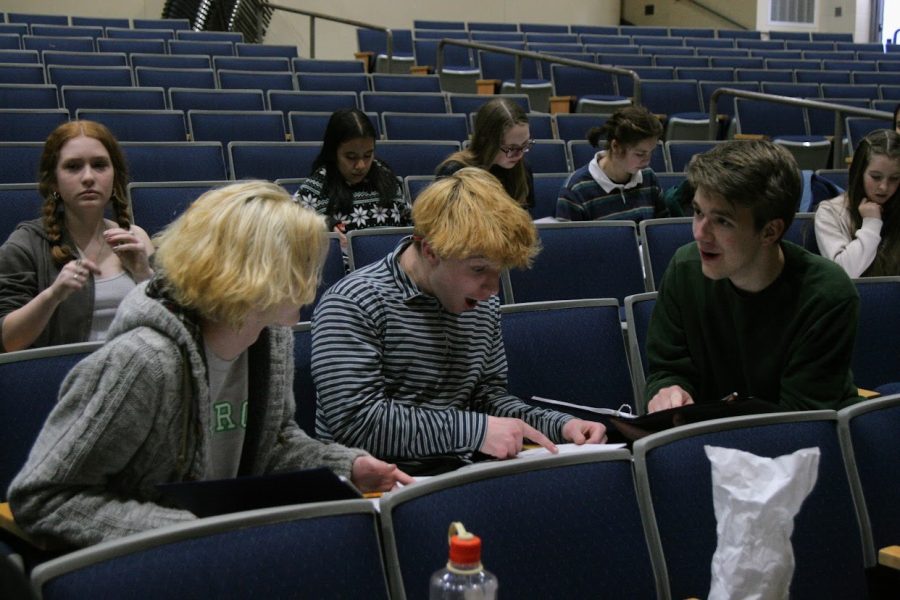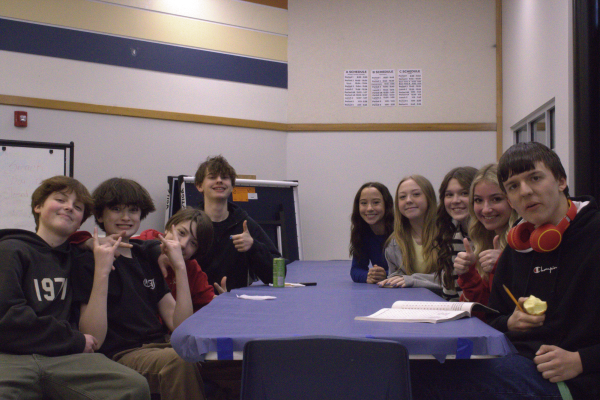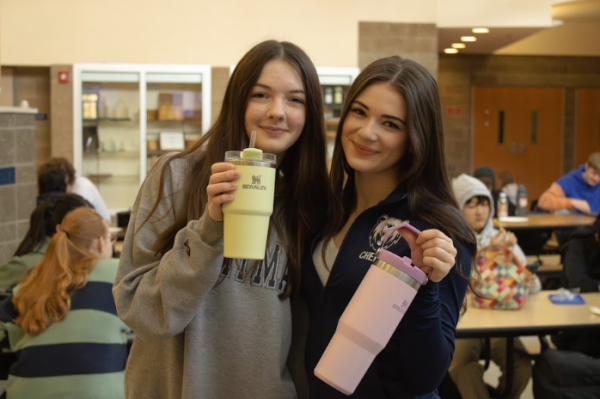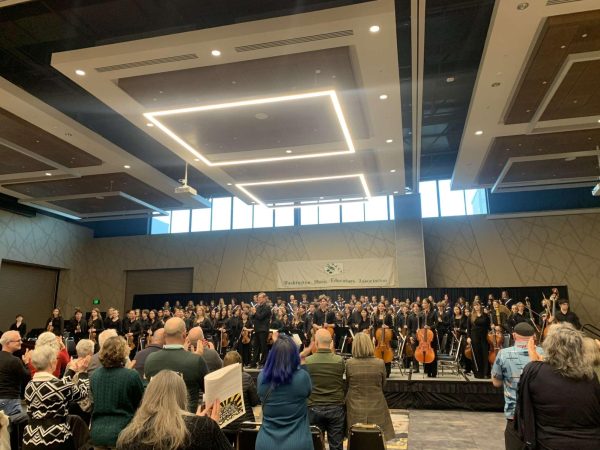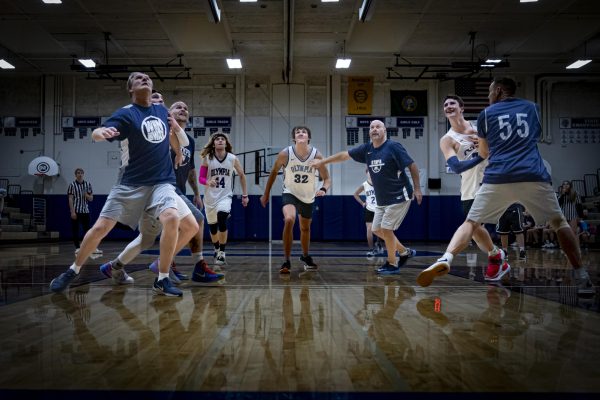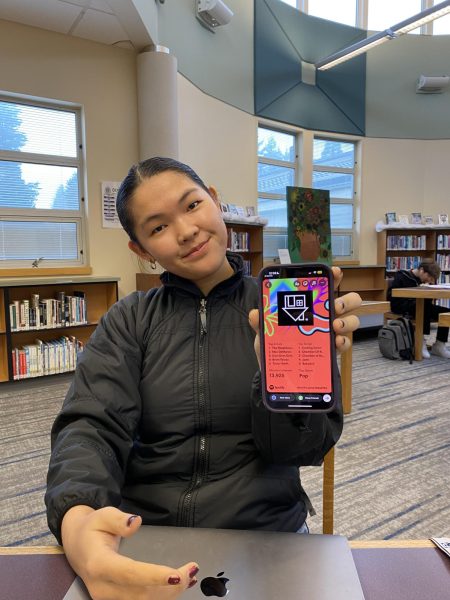ChatGPT: love or hate?
Actors Sam Hacker and Ben Jaudon transfixed by the #lovehate script. The seamless integration of AI-generated text with original Shakespeare was like nothing they’d seen before.
Most people expected technology to progress to the likes of Skynet in the Terminator films, but we’ve accomplished no such feat as of 2023. Skynet, however, can’t translate archaic Shakespeare into modern-day English within seconds. ChatGPT can.
OHS theater teacher Dallas Myers used the artificial intelligence-powered chatbot to write #lovehate, a modern adaptation of Shakespeare’s The Taming of the Shrew.
When ChatGPT came out, it put fear into the hearts of teachers everywhere. Would students never write again? But, as someone who tries to keep up with new trends, instead of shunning the new AI tool, Myers embraced it. Nearly 40% of #lovehate has been touched by AI.
After inputting various prompts into ChatGPT, Myers merged five speeches the bot had generated with the original Shakespeare that he translated himself. “I would put in stuff like, ‘Write a new speech for Katherine… where she is asserting her independence’ and it would spit out 20 lines pretty close to Shakespearean iambic pentameter. The iambic was terrible, but it would give me ideas… I could use certain pieces with a little bit of tweaking,” Myers recalled.
The final product on stage is quite different from the original. Senior Ben Jaudon, who plays Petruchio, described it as “a really interesting take” because of “a framing device that fits the story in a completely different context, and the way that characters interact with each other.” Jaudon stated that the AI-generated parts were “able to be implemented without being too obvious.”
So, since teachers can use AI to their advantage, shouldn’t students be able to as well? Myers believes so. In fact, he asks: “Why aren’t we teaching students how to use this tool?”
Myers even went on to compare ChatGPT to the personal calculator students use daily. “When [the calculator] was introduced to math classes, there was heavy resistance from teachers because they thought that math wasn’t as meaningful if you couldn’t do it in your head. But the calculator doesn’t take out the critical thinking in math, just the same way these AI-generated chat dialogue boxes aren’t able to replicate humanity. He went on to add, “I’m really bummed that Chromebooks have it blocked.”
As for ideas on how educators can implement the tool in a classroom setting? Myers has plenty. According to him, “A teacher could be like, ‘Here’s the writing prompt that you’re all gonna write about, and here’s an example essay written by an AI bot– now, make it better. Instead of having to write the whole thing, make it better. Or, have students write body paragraphs based on an AI-generated introduction.”
Eric Jacobs, English Department Head, shares a similar philosophy when it comes to use-case scenarios. “It can be an incredible tool. For example, it can generate an outline for a play… I don’t see much of a difference between an AI program doing that and us doing it together in class. It’s the same type of thing,” Jacobs explains. However, after thinking back to remote learning, he stresses that “There is a place for being in person– people crave it… so a hybrid of both could enhance the classroom in a lot of ways.”
The elephant in the room, however, can’t be avoided. Cheating has been rampant among students, many of whom would rather spend more time figuring out how not to do work than they would spend actually doing it. According to Jacobs, “As an educator, the fear is the abuse of that tool.” He affirms that the English Department’s stance is: “If you do not write your own work, it is cheating, it is plagiarism.”
Additionally, Jacobs warns that while using AI may be untraceable, it’s certainly not undetectable. “I’ve had some suspicions in the last 2 months where it just looks a little fishy because we know our students and I know what certain students… [are] capable of and what I’ve seen before, and all of a sudden I get something wildly different.”
Technological developments like ChatGPT have forced educators to reconsider the future of their classes. To Jacobs, that means reexamining how homework will function. “There are a few places to pivot: one much more project-based and portfolio-based type of learning where we develop the learning of skills over time and track growth rather than just, ‘Show me the finished product of an essay.’”
Both Jacobs and Myers agree that AI isn’t going away anytime soon. While some teachers have briefly mentioned the chatbot’s existence and others haven’t discussed it all, refusing to have an open, honest conversation will only lead to unclear expectations and misuse. Myers adds: “In education, we will ban things, which makes them more enticing to students. Because if we say, ‘Don’t use this,’ every student is like, ‘Use what? Why not?’”
In the words of OHS robotics and computer science instructor Andrew Woodbridge: “AI is a tool; it’s not inherently good or bad. Just like a lot of other tools, it needs to find its place, and we need to develop norms around its use.”
Jacobs has estimates on how long it will take for schools to adapt. “It’s going to take teachers 2 years to grapple with this and I’m talking globally, not just here. And it’s going to take another… maybe 2 years to really decide how to proceed. By that time, how good will ChatGPT be? I imagine it’s going to be pretty good.”
At the end of the day, AI is a game-changer, especially in the world of academia, and a program as accessible as ChatGPT is bringing it to the forefront for a lot of people.
However, one can’t help but wonder if this generation will be the ones to tell their kids that when they were in high school, they had to write their own essays…
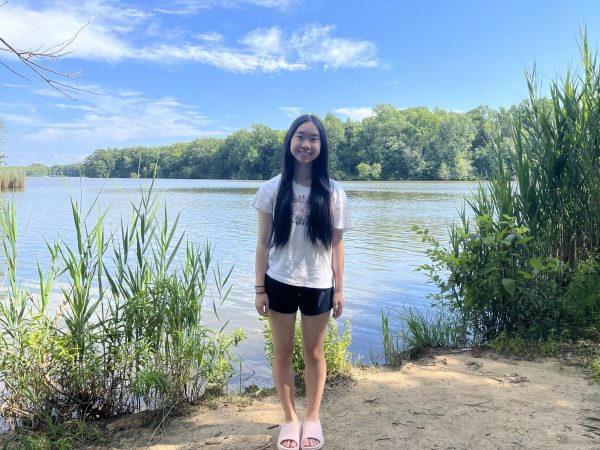
Victoria Liu is co-editor of The Olympus and creative nonfiction editor for Ursa Literary Magazine. She's also co-founder and co-president of Chinese Club....

